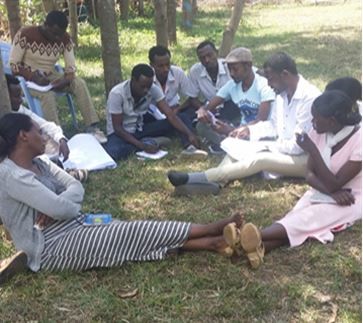
By Aschenaki Z. Kea, Kate Hawkins, and Daniel G. Datiko
Though improvements have been achieved in maternal and child health related indicators, Ethiopia still experiences high maternal mortality due to challenges related to utilization of antenatal care, skilled delivery and postnatal care.
REACHOUT has been working to improve the performance of health extension workers (HEWs) in maternal health by strengthening services provided in primary health care units. Through the intervention we have seen remarkable improvements in the uptake of maternal health services.
What did we do?
The life cycle of the REACHOUT project can be broadly divided in three phases: a context analysis and two quality improvement cycles. The context analysis was carried out to understand the barriers to and facilitators of maternal health. This informed the introduction of the first quality improvement cycle in Shebedino woreda/district in Sidama zone. The key interventions of the first quality improvement cycle included group supervision of HEWs, community engagement and strengthening referral linkage, it was led by the research team.
The second quality improvement cycle, primarily led by the woreda health system, was started by establishing a Quality Improvement Team and a technical working group (TWG) at nine health centers and woreda health offices and scaled up to six districts of Sidama zone. The intervention has transitioned from being project led to district led as a result of embedment in the health system. The health center Quality Improvement Teams are made up of five members: the head of the health center (chair), the person responsible for the Health Management Information System, the maternal and child health coordinators, a HEWs’ supervisor and the Woreda Health Office focal person for that particular health centre.
A three-day training was provided to the Quality Improvement Teams in our first workshop, which included how to identify and prioritize quality problems in maternal health, how to develop a change plan, and how to measure and document changes. They identified the root cause of the problems using problem tree and fish bone analysis exercises based on service standards, from their practice and routine reports. Some of quality problems identified and being addressed include: inadequate routine lab services for pregnant mothers including testing for HIV and syphilis; poor data quality; low coverage of fourth ANC visit and facility delivery; lack of logistics; and shortages of supplies.
Priority problems were selected by the Quality Improvement Teams based on a prioritization matrix and developed detail change plan including monitoring and evaluation mechanisms. The TWG provided technical support and oversaw the Quality Improvement Team to ensure functionality and sustainability.
The Quality Improvement Teams held regular meeting on a monthly basis to discuss the progress of the implementation of the selected quality improvement indicators and develop the next action plans based on the identified gaps. The findings were shared with the HEWs and their supervisors during group supervision meetings.
Besides the Quality Improvement Team monthly meetings, three joint workshops were held including the initial training. The two subsequent workshops addressed the problems identified in previous workshops, and reviewed the change plans developed for the identified problems, activities undertaken, successes achieved, challenges encountered, and lessons learned.
What have we achieved?
Implementation of the multidisciplinary Quality Improvement Team team has improved the efficiency of the team, quality of group supervision, and the exchange of feedback within primary health care unit.
A focal person from the woreda health office shares information about the work of the Quality Improvement Team with the woreda health office to ensure district led sustained support and learning across the health centers. The tools developed by the project have been successfully decentralized and used in health facilities, contributing to the successful provision of maternal health services. The shift from project led to district led implementation has improved the coverage of facility delivery in Shebedino woreda from 28% in 2013 at the baseline to 78% by July 2017.
Recent news
- A Community Health Worker gender action framework: Implications for decent work, rights, and responsibilities, 27 November 2017
- Reflections on the Salima Quality Improvement team experience, 20 November 2017
- Towards a Community Health Worker Gender Action Framework, 9 November 2017

This project is funded by the European Union.
